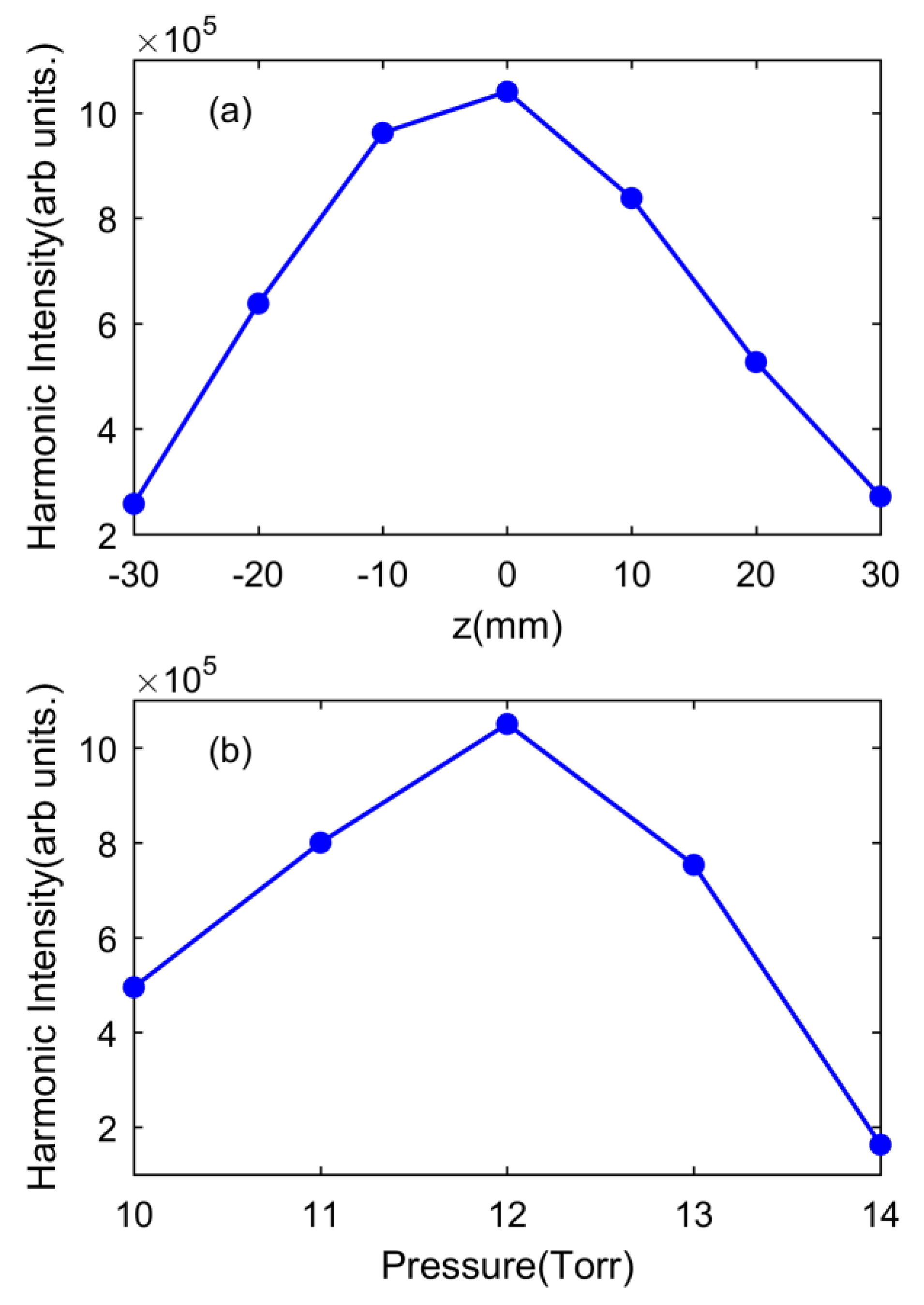Bright High-Order Harmonic Generation around 30 nm Using Hundred-Terawatt-Level Laser System for Seeding Full Coherent XFEL
Abstract
:Featured Application
Abstract
1. Introduction
2. Materials and Methods
3. Results
4. Conclusions
Author Contributions
Funding
Acknowledgments
Conflicts of Interest
References
- Ditmire, T.; Gumbrell, E.T.; Smith, R.A.; Tisch, J.W.; Meyerhofer, D.D.; Hutchinson, M.H. Spatial coherence measurement of soft x-ray radiation produced by high order harmonic generation. Phys. Rev. Lett. 1996, 77, 4756–4759. [Google Scholar] [CrossRef] [PubMed]
- Bellini, M.; Lynga, C.; Tozzi, A.; Gaarde, M.B.; Hansch, T.W.; L’Huillier, A.; Wahlstrom, C.G. Temporal coherence of ultrashort high-order harmonic pulses. Phys. Rev. Lett. 1998, 81, 297–300. [Google Scholar] [CrossRef]
- Salieres, P.; L’Huillier, A.; Lewenstein, M. Coherence control of high-order harmonics. Phys. Rev. Lett. 1995, 74, 3776–3779. [Google Scholar] [CrossRef] [PubMed]
- Lewenstein, M.; Balcou, P.; Ivanov, M.Y.; Lhuillier, A.; Corkum, P.B. Theory of high-harmonic generation by low-frequency laser fields. Phys. Rev. A 1994, 49, 2117–2132. [Google Scholar] [CrossRef] [PubMed]
- Ishikawa, K.; Midorikawa, K. Two-photon ionization of he+ as a nonlinear optical effect in the soft-x-ray region. Phys. Rev. A 2002, 65, 043405. [Google Scholar] [CrossRef]
- Mairesse, Y.; de Bohan, A.; Frasinski, L.J.; Merdji, H.; Dinu, L.C.; Monchicourt, P.; Breger, P.; Kovacev, M.; Taieb, R.; Carre, B.; et al. Attosecond synchronization of high-harmonic soft x-rays. Science 2003, 302, 1540–1543. [Google Scholar] [CrossRef] [PubMed]
- Krasnoperova, A.A.; Rippstein, R.; Flamholz, A.; Kratchmer, E.; Wind, S.; Brooks, C.; Lercel, M. Imaging capabilities of proximity x-ray lithography at 70 nm ground rules. Proc. SPIE 1999, 3676, 24–39. [Google Scholar]
- Zeitoun, P.; Faivre, G.; Sebban, S.; Mocek, T.; Hallou, A.; Fajardo, M.; Aubert, D.; Balcou, P.; Burgy, F.; Douillet, D.; et al. A high-intensity highly coherent soft x-ray femtosecond laser seeded by a high harmonic beam. Nature 2004, 431, 426–429. [Google Scholar] [CrossRef] [PubMed]
- Lambert, G.; Hara, T.; Garzella, D.; Tanikawa, T.; Labat, M.; Carre, B.; Kitamura, H.; Shintake, T.; Bougeard, M.; Inoue, S.; et al. Injection of harmonics generated in gas in a free-electron laser providing intense and coherent extreme-ultraviolet light. Nat. Phys. 2008, 4, 296–300. [Google Scholar] [CrossRef]
- Ditmire, T.; Crane, J.K.; Nguyen, H.; DaSilva, L.B.; Perry, M.D. Energy-yield and conversion-efficiency measurements of high-order harmonic radiation. Phys. Rev. A 1995, 51, R902–R905. [Google Scholar] [CrossRef] [PubMed]
- Constant, E.; Garzella, D.; Breger, P.; Mevel, E.; Dorrer, C.; Le Blanc, C.; Salin, F.; Agostini, P. Optimizing high harmonic generation in absorbing gases: Model and experiment. Phys. Rev. Lett. 1999, 82, 1668–1671. [Google Scholar] [CrossRef]
- Takahashi, E.; Nabekawa, Y.; Otsuka, T.; Obara, M.; Midorikawa, K. Generation of highly coherent submicrojoule soft x rays by high-order harmonics. Phys. Rev. A 2002, 66, 021802. [Google Scholar] [CrossRef]
- Takahashi, E.; Nabekawa, Y.; Midorikawa, K. Generation of 10-mu j coherent extreme-ultraviolet light by use of high-order harmonics. Opt. Lett. 2002, 27, 1920–1922. [Google Scholar] [CrossRef] [PubMed]
- Takahashi, E.J.; Nabekawa, Y.; Midorikawa, K. Low-divergence coherent soft x-ray source at 13 nm by high-order harmonics. Appl. Phys. Lett. 2004, 84, 4–6. [Google Scholar] [CrossRef]
- Erny, C.; Mansten, E.; Gisselbrecht, M.; Schwenke, J.; Rakowski, R.; He, X.; Gaarde, M.B.; Werin, S.; L’Huillier, A. Metrology of high-order harmonics for free-electron laser seeding. New J. Phys. 2011, 13, 073035. [Google Scholar] [CrossRef] [Green Version]
- Xu, Y.; Lu, J.; Li, W.K.; Wu, F.X.; Li, Y.Y.; Wang, C.; Li, Z.Y.; Lu, X.M.; Liu, Y.Q.; Leng, Y.X.; et al. A stable 200tw/1hz ti: Sapphire laser for driving full coherent xfel. Opt. Laser Technol. 2016, 79, 141–145. [Google Scholar] [CrossRef]
- Wang, W.T.; Li, W.T.; Liu, J.S.; Zhang, Z.J.; Qi, R.; Yu, C.H.; Liu, J.Q.; Fang, M.; Qin, Z.Y.; Wang, C.; et al. High-brightness high-energy electron beams from a laser wakefield accelerator via energy chirp control. Phys. Rev. Lett. 2016, 117, 124801. [Google Scholar] [CrossRef] [PubMed]
- Takahashi, E.J.; Hasegawa, H.; Nabekawa, Y.; Midorikawa, K. High-throughput, high-damage-threshold broadband beam splitter for high-order harmonics in the extreme-ultraviolet region. Opt. Lett. 2004, 29, 507–509. [Google Scholar] [CrossRef] [PubMed]
- Mauritsson, J.; Johnsson, P.; López-Martens, R.; Varjú, K.; Kornelis, W.; Biegert, J.; Keller, U.; Gaarde, M.B.; Schafer, K.J.; L’Huillier, A. Measurement and control of the frequency chirp rate of high-order harmonic pulses. Phys. Rev. A 2004, 70, 021801. [Google Scholar] [CrossRef]





© 2018 by the authors. Licensee MDPI, Basel, Switzerland. This article is an open access article distributed under the terms and conditions of the Creative Commons Attribution (CC BY) license (http://creativecommons.org/licenses/by/4.0/).
Share and Cite
Zhang, L.; Zheng, Y.; Li, G.; Jia, Z.; Li, Y.; Xu, Y.; Leng, Y.; Zeng, Z.; Li, R.; Xu, Z. Bright High-Order Harmonic Generation around 30 nm Using Hundred-Terawatt-Level Laser System for Seeding Full Coherent XFEL. Appl. Sci. 2018, 8, 1446. https://doi.org/10.3390/app8091446
Zhang L, Zheng Y, Li G, Jia Z, Li Y, Xu Y, Leng Y, Zeng Z, Li R, Xu Z. Bright High-Order Harmonic Generation around 30 nm Using Hundred-Terawatt-Level Laser System for Seeding Full Coherent XFEL. Applied Sciences. 2018; 8(9):1446. https://doi.org/10.3390/app8091446
Chicago/Turabian StyleZhang, Luyao, Yinghui Zheng, Guicun Li, Zhengmao Jia, Yanyan Li, Yi Xu, Yuxin Leng, Zhinan Zeng, Ruxin Li, and Zhizhan Xu. 2018. "Bright High-Order Harmonic Generation around 30 nm Using Hundred-Terawatt-Level Laser System for Seeding Full Coherent XFEL" Applied Sciences 8, no. 9: 1446. https://doi.org/10.3390/app8091446
APA StyleZhang, L., Zheng, Y., Li, G., Jia, Z., Li, Y., Xu, Y., Leng, Y., Zeng, Z., Li, R., & Xu, Z. (2018). Bright High-Order Harmonic Generation around 30 nm Using Hundred-Terawatt-Level Laser System for Seeding Full Coherent XFEL. Applied Sciences, 8(9), 1446. https://doi.org/10.3390/app8091446




